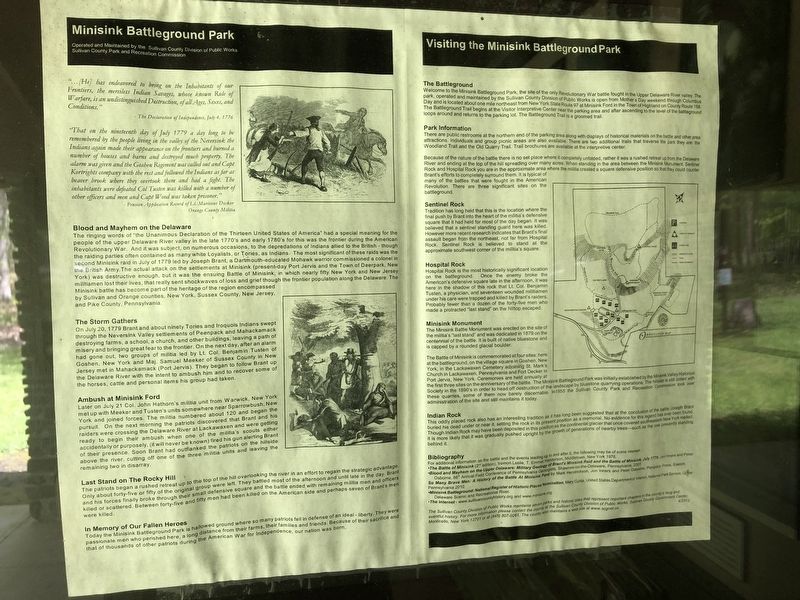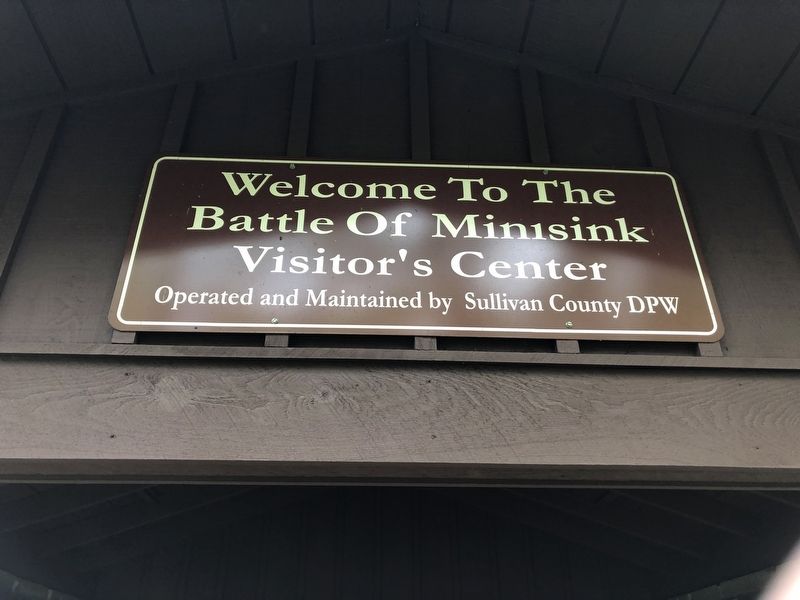Barryville in Sullivan County, New York — The American Northeast (Mid-Atlantic)
Minisink Battleground Park
"...He] has endeavored to bring on the Inhabitants of our Frontiers, the merciless Indian Savages, whose known Rule of Warfare, is an undistinguished Destruction, of all Ages, Sexes, and Conditions."
- The Declaration of Independence, July 4, 1776
"That on the nineteenth day of July 1779 a day long to be remembered by the people living in the valley of the Neversink the Indians again made their appearance on the frontiers and burned a number of houses and barns and destroyed much property. The alarm was given and the Goshen Regiment was called out and Capt Kortrights company with the rest and followed the Indians as far as beaver brook where they overtook them and had a fight. The inhabitants were defeated Col Tusten was killed with a number of other officers and men and Capt Wood was taken prisoner."
- Pension Application Record of Lt. Martinus Decker Orange County Militia
Blood and Mayhem on the Delaware
The ringing words of "the Unanimous Declaration of the Thirteen United States of America" had a special meaning for the people of the upper Delaware River valley in the late 1770's and early 1780's for this was the frontier during the American Revolutionary War. And it was subject, on numerous occasions, to the depredations of Indians allied to the British - though the raiding parties often contained as many white Loyalists, or Tories, as Indians. The most significant of these raids was the second Minisink raid in July of 1779 led by Joseph Brant, a Dartmouth-educated Mohawk warrior commissioned a colonel in the British Army. The actual attack on the settlements at Minisink (present-day Port Jervis and the Town of Deerpark, New York) was destructive enough, but it was the ensuing Battle of Minisink, in which nearly fifty New York and New Jersey militiamen lost their lives, that really sent shockwaves of loss and grief though the frontier population along the Delaware. The Minisink battle has become part of the heritage of the region encompassed by Sullivan and Orange counties, New York, Sussex County, New Jersey, and Pike County, Pennsylvania.
The Storm Gathers
On July 20, 1779 Brant and about ninety Tories and Iroquois Indians swept through the Neversink Valley settlements of Peenpack and Mahackamack destroying farms, a school, a church, and other buildings, leaving a path of misery and bringing great fear to the frontier. On the next day, after an alarm had gone out, two groups of militia led by Lt. Col. Benjamin Tusten of Goshen, New York and Maj. Samuel Meeker of Sussex County in New Jersey met in Mahackamack (Port Jervis). They began to follow Brant up the Delaware River with the intent to ambush him and to recover some of the horses, cattle and personal items his group had taken.
Ambush at Minisink Ford
Later on July 21 Col. John Hathorn's militia unit from Warwick, New York met up with Meeker and Tusten's units somewhere near Sparrowbush, New York and joined forces. The militia numbered about 120 and began the pursuit.
On the next morning the patriots discovered that Brant and his raiders were crossing the Delaware River at Lackawaxen and were getting ready to begin their ambush when one of the militia's scouts either accidentally or purposely, (it will never be known) fired his gun alerting Brant of their presence. Soon Brant had outflanked the patriots on the hillside above the river, cutting off one of the three militia units and leaving the remaining two in disarray.
Last Stand on The Rocky Hill
The patriots began a rushed retreat up to the top of the hill overlooking the river in an effort to regain the strategic advantage.
Only about forty-five or fifty of the original group were left. They battled most of the afternoon and until late in the day. Brant and his forces finally broke through their small defensive square and the battle ended with remaining militia men and officers killed or scattered. Between forty-five and fifty men had been killed on the American side and perhaps seven of Brant's men were killed.
In Memory of Our Fallen Heroes
Today the Minisink Battleground Park is hallowed ground where so many patriots fell in defense of an ideal - liberty. They were passionate men who perished here, a long distance from their farms, their families and friends. Because of their sacrifice and that of thousands of other patriots during the American War for Independence, our nation was born.
The Battleground
Welcome to the Minisink Battleground Park, the site of the only Revolutionary War battle fought in the Upper Delaware River valley. The park. operated and maintained by the Sullivan County Division of Public Works is open from Mother's Day weekend through Columbus Day and is located about one mile northeast from New York State Route 97 at Minisink Ford in the Town of Highland on County Route 168.
The Battleground Trail begins at the Visitor Interpretive Center near the parking area and after ascending to the level of the battleground loops around and returns to the parking lot. The Battleground Trail is a groomed trail.
Park Information
There are public restrooms at the northern end of the parking area along with displays of historical materials on the battle and other area attractions. Individuals and group picnic areas are also available. There are two additional trails that traverse the park they are: the Woodland Trail and the Old Quarry Trail. Trail brochures are available at the interpretive center.
Because of the nature of the battle there is no set place where it completely unfolded, rather it was a rushed retreat up from the Delaware River and ending at the top of the hill spreading over many acres. When standing in the area between the Minisink Monument, Sentinel Rock and Hospital Rock you are in the approximate area where the militia created a square defensive position so that they could counter Brant's efforts to completely surround them. It is typical of many of the battles that were fought in the American Revolution. There are three significant sites on the battleground.
Sentinel Rock
Tradition has long held that this is the location where the final push by Brant into the heart of the militia's defensive square that it had held for most of the day began. It was believed that a sentinel standing guard here was killed. However more recent research indicates that Brant's final assault began from the northeast, not far from Hospital Rock. Sentinel Rock is believed to stand at the approximate southwest corner of the militia's square.
Hospital Rock
Hospital Rock is the most historically significant location on the battleground. Once the enemy broke the American's defensive square late in the afternoon, it was here in the shadow of this rock that Lt. Col. Benjamin Tusten, a physician, and seventeen wounded militiamen under his care were trapped and killed by Brant's raiders. Probably fewer than a dozen of the forty-five men who made a protracted "last stand" on the hilltop escaped.
Minisink Monument
The Minisink Battle Monument was erected on the site of the militia's "last stand" and was dedicated in 1879 on the centennial of the battle. It is built of native bluestone and is capped by a rounded glacial boulder.
The Battle of Minisink is commemorated at four sites: here at the battleground, on the village square in Goshen, New York, in the Lackawaxen Cemetery adjoining St. Mark's Church in Lackawaxen, Pennsylvania and Fort Decker in Port Jervis, New York. Ceremonies are held annually at the first three sites on the anniversary of the battle. The Minisink Battleground Park was initially established by the Minisink Valley Historical Society in the 1890's in order to head off destruction of the landscape by bluestone quarrying operations. The hillside is stil dotted with these quarries, some of them now barely discernable. In1955 the Sullivan County Park and Recreation Commission took over administration of the site and still maintains it today.
Indian Rock
This oddly placed rock also has an interesting tradition as it has long been suggested that at the conclusion of the battle Joseph Brant buried his dead under or near it, setting the rock in its present position as a memorial. No evidence for this legend has ever been found. Though Indian Rock may have been deposited in this position as the continental glacier that once covered southeastern New York melted, it is more likely that it was gradually pushed upright by the growth of generations of nearby trees-such as the one presently standing behind it.
Bibliography
For additional information on the battle and the events leading up to and after it, the following may be of some interest:
• The Battle of Minisink (2nd Edition), Vernon Leslie T., Emmet Henderson, Middletown, New York 1976.
• Blood and Mayhem on the Upper Delaware: Military Geology of Brant's Minisink Raid and the Battle of Minisink, July 1779, John Inners and Peter Osborne, 66th Annual Field Conderence of Pennsylvania Geologists, Shawnee-on-the-Delaware, Pennsylvania, 2001
• So Many Brave Men: A History of the Battle at Minisink Ford by Mark Hendrickson, Jon Inners and Peter Osborne, Pienpack Press, Easton, Pennsylvania 2010
Erected 2012 by Sullivan County Park and Recreation Commission.
Topics. This historical marker is listed in these topic lists: Parks & Recreational Areas • War, US Revolutionary. A significant historical date for this entry is July 21, 1779.
Location. 41° 29.209′ N, 74° 58.222′ W. Marker is in Barryville, New York, in Sullivan County. Marker can be reached from Monument Road. Marker is located within the "Visitors Center" which is an open-air pavilion near the parking lot. Touch for map. Marker is at or near this postal address: 17 Monument Rd, Barryville NY 12719, United States of America. Touch for directions.
Other nearby markers. At least 8 other markers are within walking distance of this marker. Minisink Battleground Park (a few steps from this marker); The Battle at Minisink (within shouting distance of this marker); Indian Rock (about 400 feet away, measured in a direct line); Battle of Minisink Memorial (about 500 feet away); Minisink Battle Monument (about 600 feet away); In Memory of Our Fallen Heroes (about 700 feet away); Last Stand On The Rocky Hill (about 800 feet away); Hospital Rock (approx. 0.2 miles away).
Also see . . .
1. Sullivan County Historical Society. This link was listed in the Bibliography section of the marker. (Submitted on April 18, 2024, by Pete Skillman of Townsend, Delaware.)
2. Minisink Valley Historical Society. This link was listed in the Bibliography section of the marker. (Submitted on April 18, 2024, by Pete Skillman of Townsend, Delaware.)
Credits. This page was last revised on April 19, 2024. It was originally submitted on April 18, 2024, by Pete Skillman of Townsend, Delaware. This page has been viewed 48 times since then. Photos: 1, 2. submitted on April 18, 2024, by Pete Skillman of Townsend, Delaware. • Bill Pfingsten was the editor who published this page.

